

But M(OH) 2 and M(OH) 3 are stable and can be made by increasing the pH of the aqueous solution. Such as silver hydroxide Ag(OH) is unstable and it readily decomposes to form Ag 2O. Transition metals form very unstable hydroxides using their +1 oxidation state. are strong bases and are soluble in water. While the other hydroxides of this group like magnesium hydroxide Mg(OH) 2, calcium hydroxide Ca(OH) 2 etc. The beryllium hydroxide Be(OH) 2 is amphoteric in nature. Most popular and most useful bases are formed with alkali metals, such as sodium hydroxide (NaOH), potassium hydroxide (KOH), lithium hydroxide (LiOH) etc. Hydroxide ions form ionic bond with different types of metals in periodic table. Negatively charged hydroxide ion can attach with a positively charged organic ion. Hydroxides in different types of compounds Organic hydroxides In aqueous solution sodium hydroxide gives Na + and OH – ions. The metal atom has low ionization energy and gives electron to the oxygen of hydroxide to make ionic bond. The extra electron of hydroxide ion comes from a metal atom when it was a part of a compound. In hydroxide ion, hydrogen and oxygen atom shared their two valence electrons to form a covalent bond. The electronic configuration of oxygen and hydrogen are 1S 22S 22P 4 and 1S 1 respectively.

According to Arrhenius substance that forms hydroxide ion in aqueous solution is base. In aqueous solution, these base give hydroxide ion OH –. It normally attached with a positively charged metal to form a base. Hydroxide is a negatively charged ion comprised of oxygen and hydrogen atom bonded covalently with each other.


 0 kommentar(er)
0 kommentar(er)
